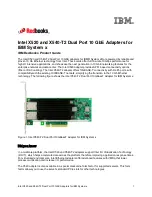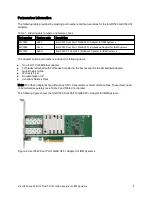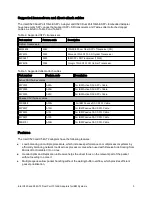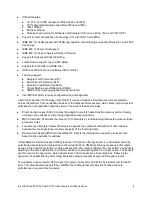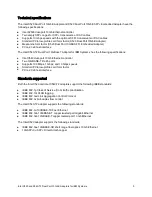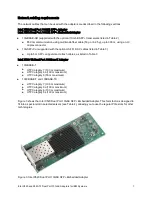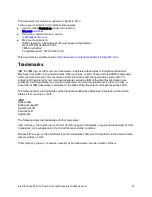
Intel X520 and X540-T2 Dual Port 10 GbE Adapters for IBM System x
4
Offload features:
IP, TCP, and UDP checksum offload (IPv4 and IPv6)
TCP segmentation/large send offload (IPv4 and IPv6)
IPsec offload
MACsec offload
Receive Side Scaling for Windows and Scalable I/O for Linux (IPv4, IPv6, and TCP/ UDP)
Support for Intel Virtualization Technology (VT) with I/OAT and VMDq.
IEEE 802.1Q VLAN support with VLAN tag insertion, with stripping and packet filtering for up to 4096
VLAN tags.
IEEE 802.3x flow control support.
IEEE 802.1p Class of Service/Quality of Service.
Support for Advanced Packet Filtering.
Jumbo frames support (up to 9,500 bytes).
Support for both UEFI and PXE boot.
iSCSI and iSCSI boot as a software iSCSI initiator.
Teaming support:
Adapter Fault Tolerance (AFT)
Switch Fault Tolerance (SFT)
Adaptive Load Balancing (ALB)
Virtual Machine Load Balancing (VMLB)
IEEE 802.3ad (link aggregation control protocol)
Intel PROSet Utility for easy configuration and management.
Intel I/O Acceleration Technology (Intel I/OAT) is a suite of features that improves data acceleration
across the platform, from networking devices to the chipset and processors, which helps improve system
performance and application response times. The suite of features includes:
Direct Cache Access (DCA): Enables the adapter to prefetch data from the memory cache, thereby
avoiding cache misses and improving application response times.
MSI-X interrupts: Minimizes the impact of I/O interrupts by load balancing interrupts across multiple
processor cores.
Low-Latency Interrupts: Allows the adapter to bypass the automatic moderation of time intervals
between the interrupts (based on the sensitivity of the incoming data).
Receive Side Scaling (RSS) and Scalable I/O: Directs the interrupts to a specific processor core
based on the application’s address.
Virtual Machine Device Queues (VMDq) reduces I/O impact on the hypervisor in a virtualized server by
performing data sorting and coalescing in the network silicon. VMDq technology makes use of multiple
queues in the network controller. As data packets enter the network adapter, they are sorted, and packets
traveling to the same destination (or virtual machine) are grouped together in a single queue. The packets
are then sent to the hypervisor, which directs them to their respective virtual machines. Relieving the
hypervisor of packet filtering and sorting improves overall processor usage and throughput levels.
The adapters have complete iSCSI support for proven native OS and VM iSCSI initiators and for iSCSI
boot. The Intel adapters support IPsec and MACsec offloads that provides full 10 Gbps line-rate
performance in secured environments.

